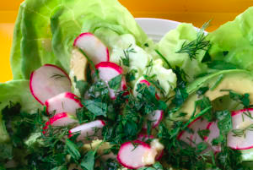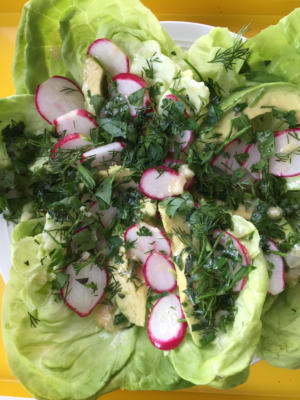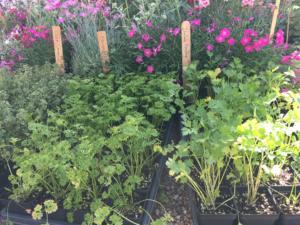
BY DENISE MILLER / FOR THE JOURNAL Wednesday, May 1st, 2019
The air at your local growers’ market this time of year is filled with the promise of the growing season ahead, and if you get up close enough, the fresh scent of herbs like mint, thyme, oregano, chervil and more.
While you’re getting yourself back in the seasonal habit of visiting your area growers’ market, you’re likely to notice a large number of locally raised plant starts – from tomatoes and arugula, to flowers and herbs.

After you purchase your weekly supply of greens, radishes, eggs, cheese, spring onions and other goodies from your favorite farmers who you may not have seen all winter, consider launching into spring with some plant starts for home – especially herbs. Herbs are easy to grow and enhance the flavor of every meal.
Cole Daeschel, owner of Cedar Grove Nursery & Greenhouse in Stanley, who sells gorgeous flowers and an extensive array of plant starts at the Santa Fe Farmers’ Market and the Eldorado Farmers’ Market, says he loves being able to help create life and share his knowledge about plants.
“Knowledge is power, and it’s especially exciting to see the younger generation that are really, really interested in growing their own garden come and buy plants,” he says.
“Sometimes people just come by to look at the pretty flowers or take pictures and ask questions, and that’s OK. I like to take as much time as I can to help people, even if they didn’t buy their plants from me.”
Why local plants?
Many grocery and hardware stores have starter plants right up front as you walk in. But if you want reliable plants – and to support area growers – try buying your starter plants from local vegetable farmers who carefully choose the varieties and how they are being grown.

Daeschel explains that the plants he brings to market are accustomed to local growing conditions, including wind, dryness, and high altitude sun. “I like to set customers up for success in growing plants. Our plants have been through various environments and that makes them hardier so they will thrive.”
Buying local also means you can ask the grower questions. “When you get to know your farmer on a personal level, you can ask what kind of inputs or fertilizers the grower is using, what’s in the soil, and other questions that are important to you,” Daeshel says.
All of Daeschel’s plants grown with organic seeds and are non-GMO. He also follows organic practices, grows sustainably, and uses biomimicry – or nature-inspired solutions.
What to buy?
If you’re new to growing herbs, you might find yourself confused by the large selection at market. “If customers don’t know what to buy, I ask them what they like to eat,” says Daeschel.

Last year Daeschel grew 18 different types of basil, and four varieties of rosemary, and he’s always interested in what customers want. If you don’t see what you’re looking for, ask your local grower if he/she might be willing to add it to their list.
Do you intend to grow the plants inside on a windowsill, outside in pots, or in the ground? If you’re planting inside, use individual pots for each herb. Containers should have drainage holes and saucers.
It’s also good to know how much sun your plant needs, and that might be very different for New Mexico than what is written on plant tags shipped from across the county.
Annual herbs like basil and cilantro go through their whole life cycle – from seed to plant and back to seed again – in one season. Biennials like parsley and sage take two years to complete their life cycle. Dill is a biennial, but since it doesn’t like frost, it acts more like an annual. Perennials like rosemary, thyme, oregano, and mint will come back year after year.

This season, challenge yourself to cook with more herbs. You’ll be surprised how easy they are to grow, and you’ll enjoy the extra flavor they add to every meal. What’s more, local growers are your best resource for plants and growing tips in your area.
BUTTER LETTUCE AND RADISH SALAD WITH FRESH HERBS
Serves 2
- 6 tablespoons extra-virgin olive oil
- 2 tablespoon champagne vinegar or white balsamic
- 2 tablespoons minced shallot
- 4 teaspoons Dijon mustard
- 1 small head of butter lettuce
- 4-6 thinly sliced radishes
- 1 avocado, peeled, pitted, sliced ½ inch thick
- ½ cup assorted whole fresh herb leaves, chopped (such as dill, tarragon, chervil, parsley, tarragon and/or cilantro)
Whisk oil, vinegar, shallot and mustard in medium bowl to blend. Season dressing to taste with salt and pepper.
Remove lettuce leaves and keep intact; rinse and dry. Arrange lettuce leaves on each plate, forming a rose shape. Tuck radish and avocado slices between lettuce leaves. Scatter fresh herb leaves over lettuce on each plate. Drizzle salad with dressing and serve.
– Adapted from bonappétit.com
SAUTÉED CARROTS WITH TARRAGON
- Sliced carrots
- Olive oil
- Butter, a dollop
- Fresh tarragon leaves
- Salt, to taste
Add sliced carrots to a hot pan with a little olive oil.
Cook over medium heat, stirring often, until tender-crisp.
Add a dollop of butter and plenty of fresh tarragon leaves, and season to taste with salt.

SPLIT PEA SOUP WITH PARSLEY AND THYME
- One ham hock, or 1 teaspoon smoked paprika
- 2 tablespoons extra-virgin olive oil, plus more as needed
- 1 medium-large onion, diced (about 2 cups)
- 4 garlic cloves, minced
- Kosher salt and black pepper
- 2 medium carrots, scrubbed and diced (about 1½ cups)
- 1 pound dried split green peas
- 2 fresh thyme sprigs
- 2 tablespoons fresh parsley
- 8 to 12 cups chicken stock or water
- Lemon wedges, for serving (optional)
If using the ham hock: In a large pot or Dutch oven over medium-high heat, heat the olive oil, then brown the ham hock until golden, about 6 minutes. If making the soup vegetarian: heat the olive oil over medium heat in a large pot or Dutch oven.
Add the onion and garlic and season generously with salt and pepper. Cook over medium heat, stirring occasionally, until tender, about 5 to 8 minutes. (If the vegetables seem dry, add a little olive oil.) Stir in the carrots, paprika (if using), half the split peas, thyme and 8 cups stock or water. Bring to a boil, then reduce heat and simmer, partly covered, stirring occasionally, for about 45 minutes until peas are tender.
If using the ham hock, remove it from the pot. Mash the soup coarsely with a potato masher or use an immersion blender for a few whirrs (watch out for the thyme sprigs). If you’d prefer a smoother soup, blend until nearly smooth.
Add the remaining ½ pound split peas and the parsley and simmer about 1 hour, or until the peas are soft. If at any point the soup looks too thick, add more stock or water; if it looks too thin, remove the lid during the second simmer until it thickens. Again, if you prefer a smooth soup, purée to desired texture.
If you used the ham hock, remove any meat from the bone, cut it into small cubes and stir into the soup. Season soup to taste with salt and pepper. Serve with lemon wedges, if desired.
– Adapted from cooking.nytimes.com
Seven favorites for the cook
Whatever your favorites, the most important thing is to have fresh herbs on hand as often as possible.
1. DILL: I have a hard time not using fresh dill on just about everything. When fresh dill is on the wane, I dry it in a paper bag and then crumble it into a jar for later use. If you’re growing dill outside it can get massive, and be sure to harvest before it goes to seed.
2. THYME: The French make great use of thyme, and its earthy flavor pairs well with other herbs. Thyme is great in all types of dishes, from soups (“Split Pea Soup with Parsley and Thyme” below) and sauces to rice and vegetable dishes.
3. BASIL: Who doesn’t love basil with tomatoes and sliced mozzarella in summer? Basil is also great in all of your Italian dishes, and of course pesto! Basil is very easy to grow indoors in a sunny window.
4. TARRAGON: Tarragon is associated with French cooking but it actually originated in Asia. It has a light licorice flavor that complements many proteins, but some favorites are roasted chicken or with sautéed vegetables like “Carrots with Tarragon” (below).
5. OREGANO: Italian sauces, pasta dishes, and Greek salads all but require oregano. It is super easy to grow and will quickly fill a huge pot. Although it is a thirsty perennial that likes regular watering, it will forgive an occasional lack of water and will come back year after year.
6. ROSEMARY: Rosemary and roasted vegetables is hard to beat. It has a needle-like appearance and a pungent aroma, and is also great stuffed under the skin of a roast chicken or on top of meat on the grill.
7. MINT: Traveling taught me the joy of fresh mint in tea and other beverages. It’s also great for seasoning yogurt. It can take over a garden bed if you’re not careful, so this one is good to put in pots, though it can get root bound.
Denise Miller is executive director of the New Mexico Farmers’ Marketing Association. Visit FarmersMarketsNM.org.

